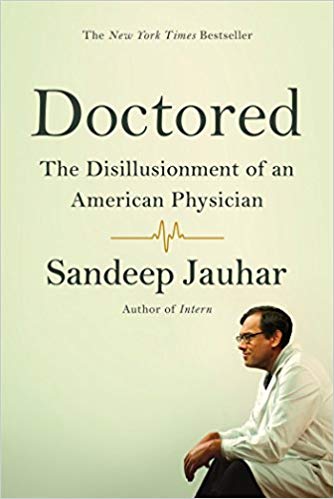Sandeep Jauhar
Farrar, Straus and Giroux
New York
2014
268 pages
According to the Art:
This memoir offers more than how Jauhar became disillusioned with American health care. Along with Jauhar’s lament are insights for other memoirists, practicing physicians, parents who want their children to become physicians, consumers of health care, and health care policy analysts among others.
Synopsis:
Very early in this memoir, Dr. Sandeep Jauhar refers to an essay Sachin Jain and Christine Cassel published in JAMA (2010) that categorizes physicians as knights, knaves, or pawns. His take: “Knights are motivated by virtue…Knaves are selfish…Pawns are passive.” (p. 7) Jauhar rides into medical practice as a knight in shining armor on a white horse after years and years of training. Would he be able to hang onto his knighthood?
The book is divided into three parts—Ambition, Asperity, Adjustment—bookended by an introduction and epilogue. Jauhar’s disillusionment with American health care is his primary theme, and it connects these three parts:
As a young adult I believed that the world was accommodating, that it would indulge my ambitions. In middle age, reality overwhelms that faith. You see the constraints and corruption. Your desires give way to pragmatism. The conviction that anything is possible is essentially gone.
pp. 5-6
Jauhar is comprehensive and unsparing in accounting for the sources of his disillusionment and his fall from knighthood. He was vulnerable to disillusionment from the start having been pushed by his parents into medicine against his desires. His mother “wanted her children to become doctors so people would stand when we walked into the room,” (p. 21) and his father said that in medicine he “would have respect, wealth, and influence.” (p. 133) He put off medical school for as long as he could by first getting a PhD in experimental physics. Finally, nineteen years after first starting college he became a practicing cardiologist, though not without almost bailing out of medical school for a career in journalism as he writes in his first memoir, Intern.*
Jauhar’s first position was as a hospital staff member heading up a heart failure unit. As hospital staff he wasn’t paid as much as physicians in private practice. This differential wasn’t a problem by itself, but because the salary was insufficient for the lifestyle he sought and his wife—a physician also—urged him to provide, “I want nice things for us: a home, safe cars, good schools. They may seem trivial to you, but they are not to me.” (p. 75) This pressure was made worse by his older brother earning twice the income while working at the same hospital as an interventional cardiologist, and as well by all the other physicians in private practice who lived in big houses and drove fancy cars.
The story then veers into a period when he sheds his knighthood for knavery. Jahaur joins a pharmaceutical company speaker bureau that supports a particular product and quits over his concern that the product may have been more toxic than first thought. Guided by his brother who says, “As much as we hate to admit it, patients are a commodity,” (p. 92) He takes positions with various private physician practices that operate more like procedure mills than health care providers.
Jauhar does not do well as a knave, realizing “I had made a Faustian bargain. Having my eyes opened to the reality of contemporary medical practice had been painful. Now I had to make a choice. Continuing on this path was leading to ruin.” (p. 257) And so he tells of his adjustment, which for him is finding an “uneasy equilibrium” (p. 258) by continuing to work with private practices, just not as much, and spending more time with his family. In the end, Jauhar does not a return to full knighthood and becomes something closer to a knight with knavish tendencies or a knave with knight-like qualities.
Analysis:
This memoir offers more than how Jauhar became disillusioned with American health care, happily so since plenty of those accounts precede this one. Along with Jauhar’s lament are insights for other memoirists, practicing physicians, parents who want their children to become physicians, consumers of health care, and health care policy analysts among others surely.
Memoirists and autobiographers often need to muster some courage if they are to provide a full airing of their story or predicament. They need courage in particular to reveal aspects of their lives and characters that they would prefer to remain private. Even more courage is needed to do the same with family, friends, and colleagues. Jauhar demonstrates this courage on several occasions when he implicates his parents, wife, colleagues, patients, and himself as causes of his knavery and disillusionment. For example, about his physician colleagues in private practice he said: “Those guys are a bunch of crooks. I see it everyday in the hospital.” (p. 75) Where his courage has its limits, though, is in his characterization of physicians as victims of circumstance: “The vast majority of physicians aren’t bad. It is the system that makes us bad, makes us make mistakes.” (p. 228) Personal choice doesn’t enter into the equation.
Jauhar is not the only physician who came into medicine with a certain ideal in mind only to become disillusioned, disheartened, and downtrodden. Through his memoir, he gives other physicians an opportunity for some catharsis. He also gives them a mirror that reflects their image as it would be a knight, a knave, or a pawn. Patients get some insights into why their physicians may not have much of a spring in their step and are even chronically grumpy. They will be alarmed to read that they are often exploited to fatten their physicians’ wallets. And parents who are pushing their children to pursue careers as physicians might think again after reading that Jauhar’s dissatisfaction and frustrations are not the exception but the rule.
For years health policy analysts have drawn attention to the wide variations in health care utilization rates and costs across different geographic areas. What they have found in essence is that health care services can generate their own demand, or as Jauhar explains it: “where there are more doctors, there is more per capita utilization of doctors’ services and testing, including consultations, hospitalizations, and stays in intensive care.” (p. 96) He then offers a view of what these large population-level findings look like at the individual patient level. He recalls a gastroenterologist saying, “If a doctor doesn’t do excess testing, forget it, he isn’t going to be able to live.” (p. 167) He recounts a conversation with a private physician who told him how he feels pressured to keep patients in the hospital longer than they need to be there because, “if I discharge a patient early, I don’t get paid at all. It’s okay if you have enough patients in the hospital, but if you don’t, you sometimes have to drag out the stay. (pp. 93-94) He reflects on his own experience working for a particular private physician practice where despite there being no solid evidence supporting the use of stress testing in patients who had recently received coronary stents, “—’s staff did this routinely. (p. 150)
Adding to Jauhar’s discontent were all the processes managed care organizations and insurers required before approving payment for various diagnostic and interventional procedures. Although he complains bitterly about these requirements, as do all physicians, he admits that it was physicians’ “pursuit of profit that made managed care necessary in the first place.” (p. 257) Physician, heal thyself.
Also:
*Jauhar is able to exercise his interest in journalism as an occasional oped contributor to the New York Times.
A version of this review is posted at the NYU Literature, Arts and Medicine Database.



